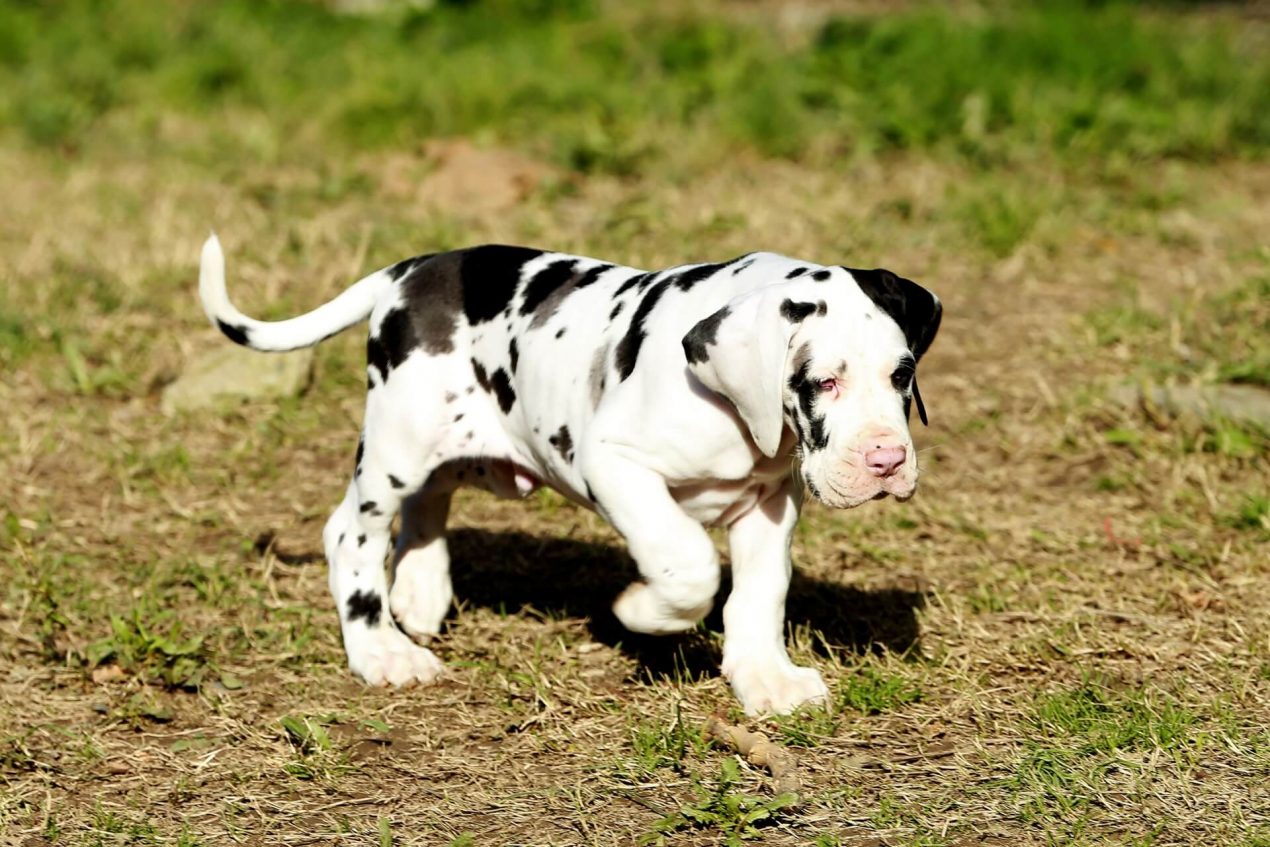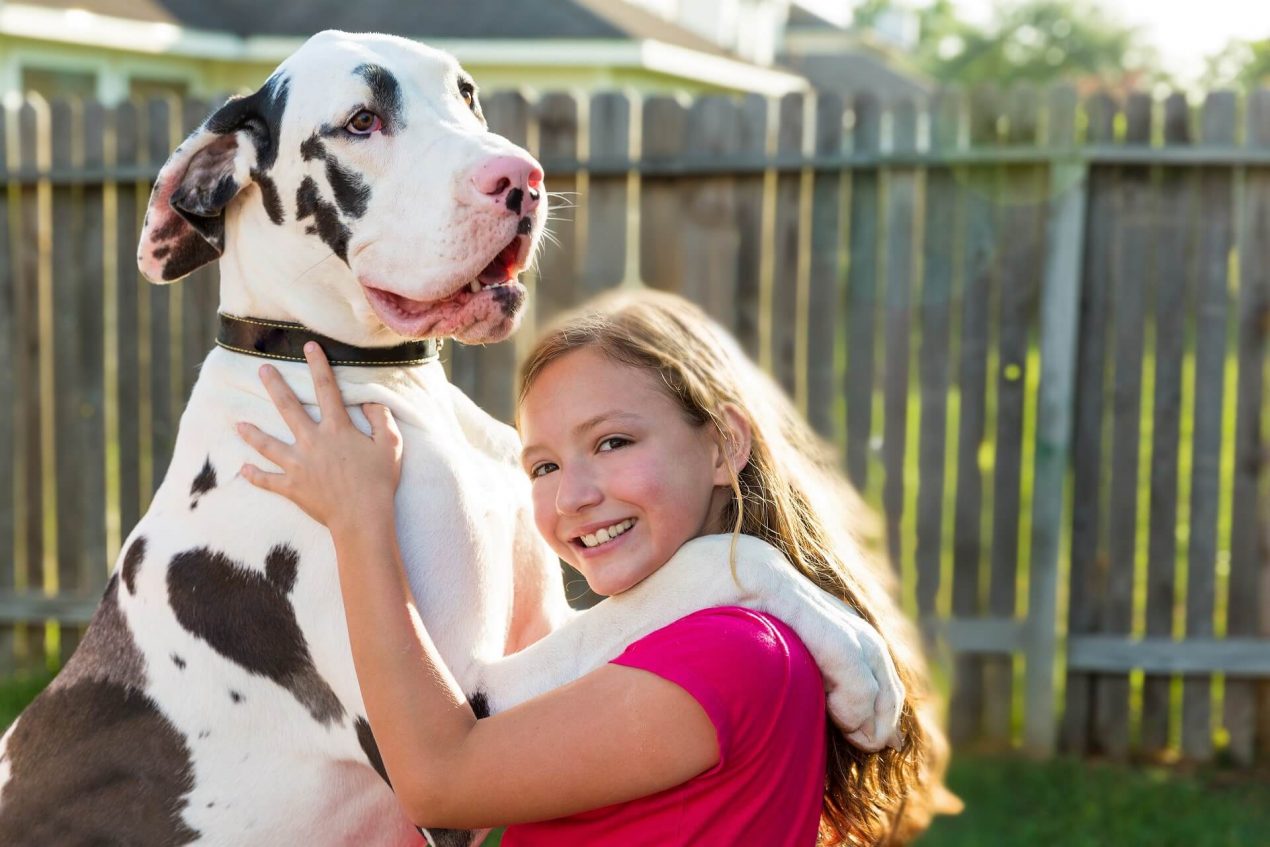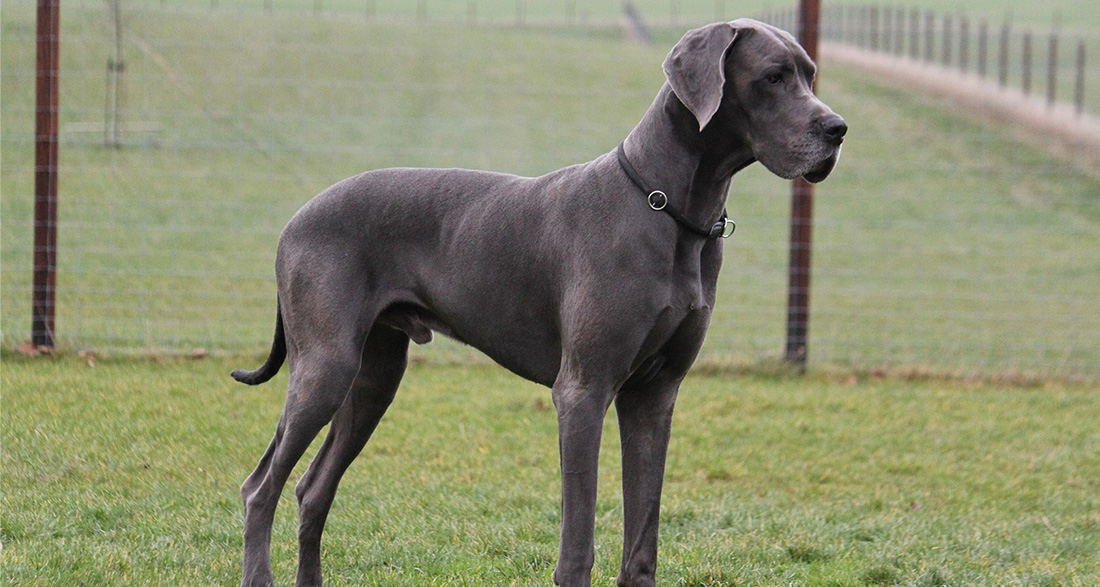The Great Dane is one of the largest dog breeds, captivating people worldwide with its uniquely friendly nature. Here, you’ll learn everything you’ve always wanted to know about the breed.
History of the Great Dane
The lineage of the Great Dane can be traced seamlessly back to the early 16th century. At that time, the English bred large, robust dogs from crossings between the broad Mastiff and the large Irish Wolfhound. These dogs were introduced to Germany, where breeding continued independently from the early 17th century. The dogs’ task was to keep prey, such as wild boars and bears, under control during hunting until the hunter could shoot them. Since these dogs were highly valuable, they were often adorned with their own armor.
As traditional big game hunting faded in the 19th century and new firearms emerged, the courageous, large hunting dogs began to disappear. However, some nobles from Ulm and its surroundings remained fascinated by the noble and imposing appearance of the breed. They started breeding the Great Dane as a luxury dog and status symbol, emphasizing a friendly, undemanding nature. The breed was now called the Ulm Dog.
Over time, the Great Dane gained more and more enthusiasts, and in 1888, they founded the Deutsche-Doggen Club in Berlin. The term “Dogge” comes from the English word “dog” . In the 19th century, the term “Danish Dog” also became popular, a name that is still used today, although the breed has little to do with Denmark. On November 18, 1961, the FCI finally recognized the Great Dane as a distinct breed. The breed belongs to FCI Group 2, Section 2, making it part of the Molossoid group. Other breeds in this group include the Rottweiler, the German Boxer, and the Hovawart.
Appearance and Characteristics
Great Danes are known for their impressive appearance. They are one of the largest dog breeds, reaching a shoulder height of up to 80 centimeters. Weighing over 90 kilograms, they are truly imposing quadrupeds. Their build is muscular and robust, giving them a majestic presence.
The head of a Great Dane is large and noble. Their eyes are usually dark and expressive, while their ears are set high and rather large. A characteristic feature of this breed is their long, slender, and slightly arched neck, which proudly carries their head.
The short coat of the Great Dane can come in various colors. The most common color variations include Blue, Black, Harlequin (spotted), and Brindle. Blue is a beautiful and rare shade that gives the Dane an elegant look. Black Danes exude power and strength. The Harlequin variant presents with different colored spots on a light or dark background, while Brindle Danes have a striped pattern that makes them unique.
Despite their impressive size and muscular build, Great Danes are known to be gentle and affectionate. Their imposing appearance doesn’t overshadow their friendly nature. They often have a gentle gaze and are known for their patience and calm demeanor.
Breed Overview
GROUP: Working
HEIGHT: 30 to 34 inches (males); 28 to 32 inches (females)
WEIGHT: 120 to 200 pounds (males); 99 to 130 pounds (females)
TEMPERAMENT: Calm, gentle, friendly, loving, even-tempered, attentive, proud
COAT: Short, smooth coat
COAT COLOR: Black, black and white, blue, brindle, fawn, harlequin, merle, silver, solid white, or mantle
HYPOALLERGENIC: No
LIFE SPAN: 6 to 8 years
Traits and Characteristics
The immense size and impressive appearance of the Great Dane may seem intimidating at first glance. However, the fear of this large dog is usually entirely unfounded. On the contrary, Danes are extremely affectionate and loving. In the breeding of Great Danes today, emphasis is placed on a friendly and calm nature. Like affectionate giant babies, they often underestimate their own size and attempt to snuggle into their owner’s lap. Great Danes get along well with other pets and are fond of children. Is a Great Dane a family dog? Due to their loving and affectionate nature, the Great Dane makes a good family dog. They are generally wary and reserved towards strangers and, due to their impressive appearance, make excellent guard dogs.
| Affection Level | High |
| Friendliness | High |
| Kid-Friendly | High |
| Pet-Friendly | High |
| Exercise Needs | Medium |
| Playfulness | High |
| Energy Level | Medium |
| Trainability | Medium |
| Intelligence | Medium |
| Tendency to Bark | Medium |
| Amount of Shedding | High |
Acquiring a Great Dane
If you are considering getting a Great Dane, you have chosen a fascinating and majestic breed. However, there are some essential things to consider before welcoming this large and loving dog into your home. Here are some tips for acquiring a Great Dane:
- Research and Preparation: Thoroughly research the breed to ensure it fits your lifestyle and needs. Great Danes are large dogs that require a lot of space and exercise.
- Reputable Breeder: Look for a reputable breeder who breeds healthy and well-socialized Great Danes. Visit the breeder in person to assess the parent dogs and living conditions.
- Health Check: Ensure that the puppies have been examined for possible genetic diseases and have received all necessary vaccinations and deworming.
- Home Preparation: Create a safe and comfortable area for your Great Dane in your home. Provide enough space, a cozy dog bed, and toys.
- Cost: Consider that acquiring a Great Dane comes with expenses. In addition to the purchase price, there are costs for food, veterinary care, insurance, and possibly dog training.
- Time and Attention: Great Danes are loving dogs that require a lot of time and attention. Make sure you have enough time for walks, training sessions, and affectionate care.
- Patience and Commitment: Great Danes are intelligent but can be independent. Give them the time and patience they need for proper training and socialization.
By following these tips and carefully preparing for the acquisition of a Great Dane, you can ensure that you have a loving and loyal companion for many years.
How to Care for a Great Dane
If you’ve decided to welcome a Great Dane into your family, it’s important to provide a loving and well-structured home for them. Here are some tips on how to keep your Great Dane happy and healthy:
- Exercise and Activity: Great Danes require regular exercise to expend their energy. Take them on extensive walks and provide opportunities for free running in a secure area.
- Feeding and Nutrition: Pay attention to a balanced and high-quality diet for your Great Dane. Consult your veterinarian for the best food options and follow recommended portion sizes.
- Veterinary Care: Ensure regular veterinary check-ups, vaccinations, and deworming for your Great Dane. Regularly screen them for possible genetic diseases.
- Basic Training: Start early with the basic training of your Great Dane. Train them on fundamental commands like “sit,” “stay,” and “come.” Reward good behavior with praise and treats.
- Socialization: Familiarize your Great Dane early with various environments, people, and other animals. Take them to dog parks and allow them to interact with other well-socialized dogs.
- Grooming: Regularly brush your Great Dane’s short coat to keep it healthy and shiny. Also, clean their ears regularly and trim their nails when needed.
- Love and Attention: Provide your Great Dane with the love and attention they need. Spend time playing, cuddling, and show them that they are a valued family member.
By following these tips and offering your Great Dane a loving and well-structured environment, you can ensure they lead a happy and fulfilling life.
What to Consider When Buying?
Is the Great Dane a beginner’s dog? A Great Dane is not a dog for beginners, primarily due to its size. Before getting a Dane, consider if you can provide enough space for such a large dog. A small city apartment is not suitable for a Dane. Additionally, avoid keeping them in a house with many stairs, as this can harm their bones and joints. While most Danes have a relatively short lifespan, around eight years, during this time, you bear full responsibility for the animal.
If you meet all the criteria, the next step is to find a suitable breeder. For a purebred Great Dane from a reputable breeder, you should budget around $1000 to $1200. Some private breeders offer dogs without papers at a lower cost, but be cautious, as poorly bred Danes can be prone to health issues. The breed officially comes in five different colors in three categories: “Yellow and Brindle,” “Harlequin and Black,” and “Blue.” The choice of gender is also essential, as males can be considerably larger and heavier, appearing more imposing, while females are smaller, lighter, and more elegant.

Puppy Development and Training
While Great Danes have a naturally friendly character, early training is crucial for their future development. The main challenge in training such a large dog is the animal’s immense physical superiority. An adult male can easily weigh 90 kilograms and is challenging to control without proper training. Since few people can physically control a Dane, alternative measures like using a Halti (head collar) or an anti-pull harness can be helpful in training.
However, for your dog to be obedient without aids, focus on consistent training from a young age. Don’t allow your puppy to get away with behavior that would be unacceptable in an adult dog. Given the Dane’s sensitive nature, they respond well to positive reinforcement and cannot tolerate harshness. A poorly trained Dane can become dangerous and aggressive.
Activities with the Great Dane
Despite their size, Great Danes do not have a significantly greater need for exercise than other dogs. Most Danes are content with daily extensive walks and are not particularly suited for jogging companionship. Occasionally, you can go for a bike ride or take longer walks, but avoid areas with a high concentration of wildlife. Some members of the breed have a hunting instinct and might pull you suddenly while biking.
Excessive strenuous exercise is harmful to the joints of large dogs. They prefer to be mentally and playfully challenged, being enthusiastic about any kind of intelligence toy due to their natural aptitude as scent hounds. If you still want to engage in dog sports with your Dane, focus on calm activities like Obedience or tracking.

Health and Care
As the coat of the Great Dane is very short and hard, grooming is minimal for this breed. Like other dogs, Great Danes shed their coat in spring and fall, transitioning from winter to summer fur. However, due to the structure of individual hairs, they can be easily vacuumed or swept up. Overall, you have little to no work when it comes to coat care for Danes. During shedding, it is advisable to use a rubber brush.
To keep your Dane healthy and fit, it is crucial to ensure that the tendons and muscles of the dog are well trained. Especially in adulthood, long daily walks should be part of the routine. However, puppies should not be overexerted.
Common Health Issues
Due to their immense size, Great Danes are prone to bone cancer and gastric torsion. Hip dysplasia and the heart muscle disease DCM (dilated cardiomyopathy) are also common health problems. DCM involves the enlargement of one or both heart chambers, resulting in insufficient pumping, and too little blood reaches the body. Due to these conditions, 28% of Great Danes die before reaching the age of five. To counteract the risk of such diseases, it is recommended to provide the animal with appropriate exercise and a proper and balanced diet.
For this, consult your veterinarian or breeder. Is the Great Dane a breed of suffering? The so-called porcelain tiger is the result of color mixing breeding. This practice has increased significantly for over 25 years. However, breeding double-merle Danes, where two spotted Great Danes are paired, can lead to breed-related diseases such as blindness and deafness, making them suffering breeds. When purchasing a Great Dane, make sure that the breeder focuses on the health and longevity of the animals, rather than just emphasizing size.
Conclusion
The Great Dane is a fascinating and majestic dog breed. Its imposing size and affectionate character make it a unique pet. With proper care, training, and attention, Great Danes can become loyal and faithful companions.
Frequently Asked Questions
- Are Great Danes aggressive? No, Great Danes are generally not aggressive. They are gentle dogs known for their friendliness and patience.
- Do Great Danes need a lot of exercise? Yes, Great Danes require regular exercise to stay healthy and happy. Daily walks and playtime are essential for their well-being.
- Can Great Danes be kept in apartments? While Great Danes need a lot of space, they can be kept in apartments under specific conditions. It is crucial to provide them with sufficient outdoor exercise.
- Are Great Danes suitable for beginners? Great Danes can be a good choice for experienced dog owners familiar with large breeds. Due to their size and strength, they may pose a challenge for beginners.
- How long do Great Danes live? The average lifespan of a Great Dane is between 8 and 10 years. With proper care and veterinary attention, they can live even longer.


